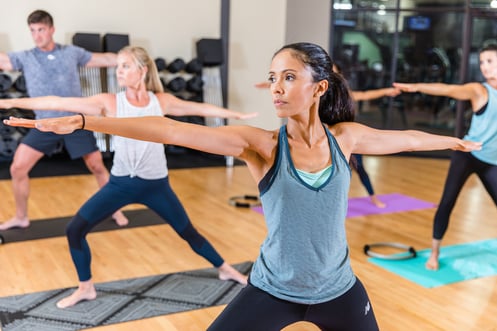As the weather gets warmer, we get busier and busier. It can be hard to find time to fit in a workout, let alone a stretching session. After you've driven to the gym, changed into workout clothes, and spent 45 minutes on the treadmill or weight training, the last thing you want to do is take even more time out of your day to stretch.
Why bother? You've got places to be!
Sport-specific stretching is essential for walkers, runners, and athletes of all kinds not only for preventing injury but also for improving circulation, range of motion, and flexibility.
Fortunately, even a quick and simple stretching routine still provides you with significant benefits. We're sharing 6 simple stretching tips to add to your daily workout routine. (Even if you're just walking, trust us when we say your body will thank you!)
6 Stretching Tips for Walkers and Runners
Never stretch a cold muscle.
Stretching a cold muscle can be risky because you can potentially pull, strain, or even tear a muscle if you force it into a stretch without being warmed up first. Start by walking or lightly jogging for about 5 minutes THEN stretch. Your muscles need adequate blood flow to relax and elongate (aka the goal of stretching.)
Stretch both sides equally.
Even if only one side feels tight or sore, you need to stretch both sides of the body equally. Maintaining symmetry in your body is key to avoiding overuse and injury. Moving both sides the same way will allow for an even and consistent movement pattern.
For walking and running, try stretching the following muscle groups in pairs: Quadriceps and Hamstrings (front and back of the upper leg), Glutes and Hip Flexors (front and back of hips), and Calves and Shins (lower part of the leg).
Hold each stretch for 20-30 seconds.
Just like completing multiple sets of an exercise, you should do multiple holds of a stretch to get the most benefits. Holding the stretch for 20-30 seconds is the optimal amount of time that will give the muscle time to relax and elongate.
Know the difference between Static and Dynamic Stretches.
Stretching is a key part of any workout routine, but not all stretching is equal. There are two main types of stretching: static and dynamic. Both have their benefits, BUT they should be used during different times in your workout.
Click here to learn more about using Static Stretches vs Dynamic Stretches in your workout routine.
Ease into the stretch.
During static stretches, you should be holding the position. When getting into a stretch, you should ease into it to the point where you can feel that there's tension in the muscle, but not so much that it's painful. If the stretch hurts, stop as you could potentially rip a muscle by stretching too fast or too far.
If you get into a stretch that you want to release immediately (even after easing into it gently), it might be a sign that you need to spend more time focusing on stretching and gaining mobility in this area.
Breathe as you stretch.
When you feel a little uncomfortable stretching, it can be tempting to hold your breath. Don't do that! Breathing while you stretch increases the circulation of oxygenated blood, relaxes the body and the mind, plus it helps get rid of lactic acid buildup.
Remember, stretching should be a part of your regular routine to fully reap all the benefits. (Stretched muscles are happy muscles!) So use these tips and start making time for a proper warm-up and cool down in your walking or running routine and experience the positive impact it'll have on your flexibility, performance, and overall well-being!








Leave A Comment